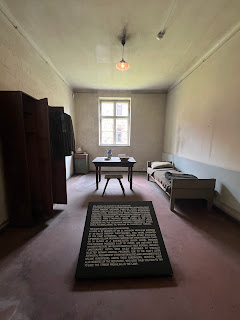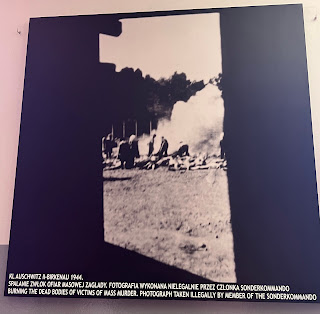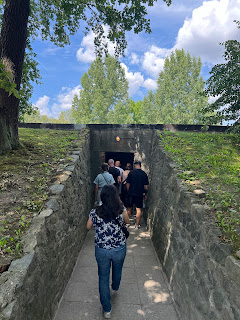I’ve decided to split our time in Kraków into a post dedicated to our time remembering the Holocaust and a post seeing Kraków.
Our first visit was to Schnidler’s Factory. Today the factory has been turned into a museum that chronicles the events leading up to the Holocaust and what Oskar Schindler did to save 1,200 Jews. There are none of the manufacturing equipment left as it had all been moved to Czechoslovakia during the war but Schindler’s office is still the original and the artifacts in the museum were the belongings of the Jews taken off to the camps. The tour was average for anyone with a decent amount of knowledge of Schindler, his story and the Holocaust.
 |
| The symbol of Polish Resistance |
In Poland, the Star of David the Jews were required to wear was blue on a white background, however, in the rest of Europe, it was a yellow star. The Star of David from Poland later became the flag for Israel.
 |
| Desk of Schnidler’s secretaries |
 |
| Itzhak Stern (Schindler’s accountant) used this typewriter to create the list. |
 |
| Schindler’s Desk |
At Auschwitz, we went into several of the block houses and each with an exhibit to specific subjects. The first one we entered had a hall lined with photos those that were used for either experiments and later murdered or those that were killed shortly after arrival.
Between 1941-1943 in the courtyard between blocks 10 and 11,
SS men shot several thousand people at the Death Wall.
Block 4 was dedicated to the explanation of the Extermination. Due to some of the graphic photos and some human remains (hair that was used to make textiles), I didn’t take a lot of photos and in some cases photos were not allowed. I did take a few pics of signs that resonated with me. The first sign below is a quote I have always thought was so very important for everyone to remember. Sadly in the US these days, we seem to think erasing historical figures, actions or events will appease people and make them feel better. We can’t hide or erase what has happened and it is important to remember them and talk about them so that they are never repeated again.
 |
| Jews and others Hilter considered inferior were brought from all over Europe to Auschwitz-Birkenau |
When prisoners were brought to the camps, other prisoners were assigned to go through all of their belongings and sort them into various piles so the Germans could use them for either personal use or to further support the war efforts. These prisoners were part of a unit called, Sonderkommando and their job was to sort personal belongings. Some of the brave Sonderkommando would smuggle items that could be used by prisoners in the camps. The bravest of the brave also smuggled cameras and took photos to show the crimes committed by the Germans. This is one of the photos.
 |
| Canisters which contained Zyklon B Pesticide used for killing victims in the gas chambers |
The final part of our tour of Auschwitz was walking through the crematorium where thousands were murdered.
 |
| Tracks that carried the trains |
As the prisoners were taken off the trains, they were sorted in this area. The young and healthy were sent in one direction and put to work in the camp. The old and unhealthy were sent in another direction and sent to the chambers.
 |
| The chimneys are from the original barracks. There were two chimneys per building. |
One of the things we noticed were all the wildflowers and we couldn’t help but wonder if they existed when the camp was active. If they were, did the flowers provide any hope for the prisoners?























































No comments:
Post a Comment